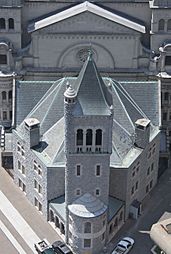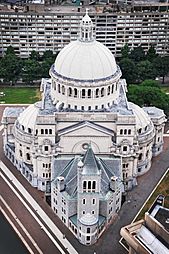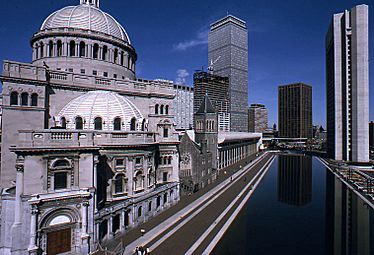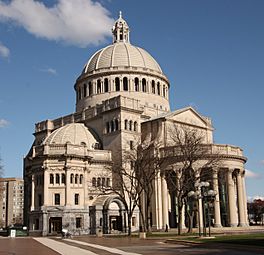The First Church of Christ, Scientist facts for kids
Quick facts for kids The First Church of Christ, Scientist |
|
|---|---|
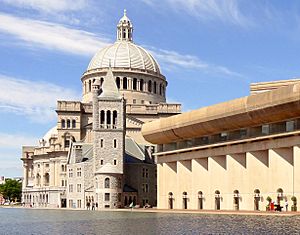
The original Mother Church (1894) and behind it the domed Mother Church Extension (1906). On the right is the Colonnade building (1972). The reflecting pool is in the foreground.
|
|
| 42°20′40″N 71°05′06″W / 42.34443°N 71.084872°W | |
| Location | Christian Science Center 250 Massachusetts Avenue Boston, Massachusetts |
| Denomination | Christian Science |
| Website | The First Church of Christ, Scientist |
| History | |
| Founder(s) | Mary Baker Eddy |
| Architecture | |
| Functional status | Active |
| Architect(s) | Franklin I. Welch (1894) Charles Brigham (1904–1906) S.S. Beman (1904–1906) |
| Architectural type | Romanesque (Original Mother Church); Italian Renaissance (Mother Church Extension) |
| Groundbreaking | 1893 |
| Completed | 1894 (Original Mother Church) 1906 (Mother Church Extension) |
| Specifications | |
| Capacity | 900 (Original Mother Church) 3,000 (Mother Church Extension) |
| Dome height (outer) | 224 ft (68 m) |
The First Church of Christ, Scientist is the main headquarters for the Christian Science religion. It is also called the mother church because it's the central church for all other Christian Science churches worldwide. The religion was started in the 1800s by Mary Baker Eddy after she published her book, Science and Health, in 1875.
This church is located at the large Christian Science Plaza in Boston, Massachusetts. The plaza is a 13.5-acre (55,000 m2) area owned by the church. It includes several important buildings: the Original Mother Church (built in 1894), the much larger Mother Church Extension (1906), and the Christian Science Publishing House (1934). There is also a large reflecting pool and a fountain.
Contents
History of the Church
The first building, now called the Original Mother Church, was finished in December 1894. It was designed by an architect named Franklin I. Welch. This was not the very first Christian Science church ever built, but it was the main one.
The Two Main Buildings
The original church is a stone building made in a style called Romanesque Revival. This style was meant to look like old buildings from the Roman Empire. Even though it was large for its time, it looks small next to the newer building. It has a 126-foot (38 m) tall steeple and can seat 900 people. The stone used to build it came from New Hampshire, which was Mary Baker Eddy's home state.
A much larger building, called the Mother Church Extension, was added between 1904 and 1906. It has a giant dome and was designed to look more like buildings from the Neoclassical style. This extension has one of the world's largest pipe organs. Its main room, called the sanctuary, is on the second floor and is big enough to seat about 3,000 people.
The Christian Science Plaza
The Christian Science Plaza is a well-known landmark in Boston that many tourists visit. It was designed in the 1960s by the famous architecture firm I.M. Pei & Partners. Besides the two churches, the plaza has a large administration building, a long open hallway with columns called a colonnade, and a beautiful reflecting pool and fountain.
Mary Baker Eddy Library
The Mary Baker Eddy Library is also on the plaza. It is inside an 11-story building that was first built for the Christian Science Publishing Society. A famous attraction inside the library is the Mapparium. It is a giant, three-story globe made of stained glass that you can walk inside. It shows a map of the world as it was in 1934. The library was updated and reopened in 2002.
Branch Churches Around the World
The Mother Church in Boston is the main church, but there are many "branch churches" all over the world. According to the church's rules, only the main church in Boston can be called "The First Church of Christ, Scientist."
Other churches are named based on when they were built in a city. For example, you might see "First Church of Christ, Scientist, Chicago" or "Seventeenth Church of Christ, Scientist, Chicago." Each branch church manages its own business, but they all follow the main beliefs of The Mother Church.
Gallery


